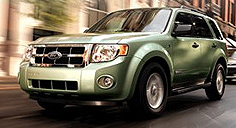Our designers love to find new, beautiful designs for our vehicle interiors. Recently, they've had the opportunity to make the whole design and aesthetics process take on greater meaning by incorporating more "green" fabrics and materials into the next generation of vehicle interiors.

Designing Sustainable Interiors
Our designers took their first step toward sustainable interior design when they delivered seat fabric made from 100 percent post-industrial materials for the 2008 Ford Escape, but that was just the beginning.
We're currently looking to expand the use of sustainable seat fabric beyond the SUV to all types of vehicles. And we're working with our suppliers to improve the overall feel of the fabric. We want it to be softer and silkier to the touch.
Will Consumers Pay for Sustainable Materials?
Our suppliers have begun offering our designers a wider array of sustainable materials to choose from. However, cost is still a factor—the materials are harder to get, and it takes more time and resources to develop them.
Our designers must consider whether consumers are willing to pay a higher price for a greener vehicle. To address this issue, they've decided to combine sustainability with luxury or high-performance until suppliers find ways to lower the costs of sustainable materials.
Lincoln MKR Concept
The Lincoln MKR concept vehicle is our example of guilt-free luxury. It features several innovative interior solutions, beginning with the extensive use of wood on the instrument panel. This wood is a reengineered oak, which has been recycled and reassembled grain by grain, and stained black to give the wood a warm, rich appearance without using additional trees.
Leather is another key interior material that customers expect in luxury vehicles. We've found a way to deliver a more environmentally friendly leather called "chrome-free"' leather. When tanning the leather, the new process is chromium-free and minimally impacts the environment.
In addition to recycled wood and chrome-free leather, the Lincoln MKR concept includes renewable soy foam seat bases and mohair carpet. This unique combination of materials gives the Lincoln MKR concept a rich-looking interior while demonstrating the more environmentally friendly amenities luxury buyers are expecting in premium goods, including vehicles.
2008 Ford Escape Hybrid
The 2008 Ford Escape uses seating surfaces made from 100 percent post-industrial materials, supplied by InterfaceFABRIC, Inc. InterfaceFABRIC estimates that Ford's use of post-industrial materials, rather than virgin fibers, could conserve an estimated 600,000 gallons of water, an estimated 1.8 million pounds of carbon dioxide equivalents, and the equivalent of more than 7 million kilowatt hours of electricity annually.
Getting Greener
There are many applications that we're looking at to improve the greening of our vehicles, but not all of them are things that will be visible to consumers. For instance, we'll be launching the soy foam technology in the seat cushions and seat backs of the 2008 Mustang, and designers are currently examining ways to implement the recycled wood veneers and chrome-free leather seats featured in the MKR in future vehicles.
We're also developing a sustainable replacement for the fiberglass now used between the headliner of a vehicle and the roof sheet metal. The material we've developed as a replacement is bio-based, improves acoustics in the vehicles and neutralizes odors. In addition, it's lighter than fiberglass, which will help enhance fuel economy.

